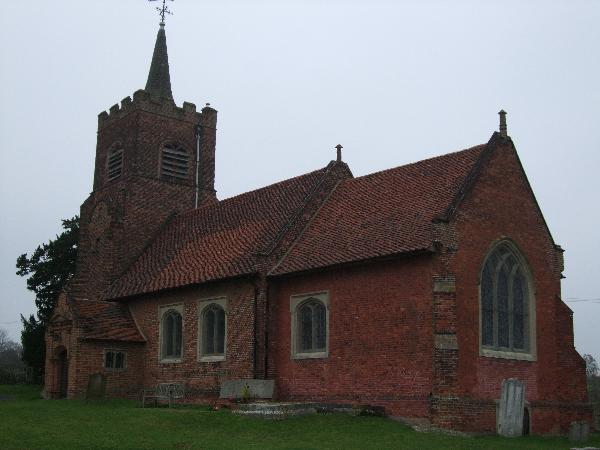St Michael, Theydon Mount

There appears to have been a church at Theydon Mount in 1236, for in that year Robert, parson of the church at Theydon, was involved in a dispute with Robert de Briwes and his wife Beatrice over 26 acres of land. Since 1755 the rectory of Theydon Mount has always been held jointly with that of Stapleford Tawney although not formally united with it, there is a foot path across the fields to Stapleford Tawney Church where you can find another micro in this series.
The original parish church of Theydon Mount was dedicated to St Michael and St Stephen. In 1400 the Pope offered indulgences to those who should visit the church and contribute to its upkeep. This church was burnt down in 1611; it is said to have been struck by lightning. The present church was certainly in use by 1614. Unlike its predecessor it is dedicated to St Michael only. It adjoins the park of Hill Hall.
The church consists of nave, chancel, south porch, and west tower. It is of red brick with plaster dressings. Its special interest lies in the fact that it dates from the single period 1611-14 and has had few alterations. One or two early renaissance details have been used but the main structure is of late gothic style and arrangement
Externally the window and door openings are of moulded brick covered with plaster to simulate stone. The windows on the north and south sides and in the upper stages of the tower have four-centred heads. The larger east and west windows have interlacing tracery and may date from the 18th century.
The square tower is of three stages with a castellated parapet and a small shingled spire. The stair turret on the north side reaches to the belfry and has splayed angles. Near the top these are corbelled out to give a square section, a feature which is also found on a stair turret at Hill Hall. The parapet is of moulded brick and has a segmental pediment. The stair is lighted by pierced quatrefoil openings.
The south porch has a curvilinear gable with a heavily moulded brick coping. The archway is fourcentred with classical imposts from which rise flanking pilasters supporting an entablature and pediment. This entrance feature is plaster covered and is the only typically renaissance detail to be found externally.
Inside the church the chancel and tower arches are pointed and the general impression is gothic. Many of the fittings are of the original date. The marble font, which stands against the west splay of the south doorway, is of most unusual design and may be by the same hand as some of the family monuments which are described below. The stem consists of a square pillar supporting a moulded bowl of black marble. Above the bowl is a bearded mask set in a shell-headed niche.
In the west window are several pieces of heraldic glass of the 16th century and later, all of which have been moved from Hill Hall. They include a Tudor royal arms, crowned badges of Henry VIII and Elizabeth I, the arms of Sir Thomas Smyth, and a damaged achievement of arms that has not been identified. On the south wall of the nave the Lord's Prayer and the Creed are painted in black letter of the original date. The Ten Commandments in similar script are visible above the chancel arch. The oak benches in the nave are apparently original. The reredos, which has coupled and fluted Corinthian pilasters, dates from about 1700. The black and white floor paving is of the same period.
There is one bell cast by John Clifton in 1653.
There is a fine series of monuments to the Smyth family. The first of these, that of Sir Thomas Smyth (d. 1577) and 'Philip' his wife (d. 1578), was preserved from the earlier church. It is of alabaster and black marble and stands against the north wall of the chancel. The reclining effigy of Sir Thomas is in armour and Garter robes and has a salamander at its feet. Below is an inscribed altar tomb and above an arched canopy under which are a long inscription and symbolic carving. There are flanking Ionic pilasters supporting an entablature. Above the cornice are two black marble obelisks and an achievement of arms.
Opposite is a monument of similar proportions to Sir William Smyth (d. 1626) and Bridget his wife. A crested helmet and part of a surcoat, said to have belonged to Sir William Smyth, hang near by together with a painted cartouche shield.
Against the north wall of the chancel is the alabaster tomb of the second Sir William Smyth (d. 1632). The carving is of fine quality and the costumes are of great interest. Opposite this monument is an alabaster and black marble tomb enriched with consoles and cherubs' heads. On it is the recumbent effigy of Sir Thomas Smyth, bt. (d. 1668), in armour and with a curled wig.
On the walls of the chancel are many tablets to members of the Symth family dating from the 18th and 19th centuries, and several painted hatchments of the same family. The two black-letter inscriptions on the south wall of the nave have been adapted as memorials. One serves as a memorial for the First World War and the other is in memory of Sir Robert Hudson (d. 1927).
The cache
You’re looking for a 35mm film canister. The cache has a log book but no pen so please bring one with you. Be careful of the road whilst looking for the cache.
Church Micro Series
If any body would like to expand to this series please do, could you please let sadexploration know first so he can keep track of the Church numbers and names to avoid duplication.